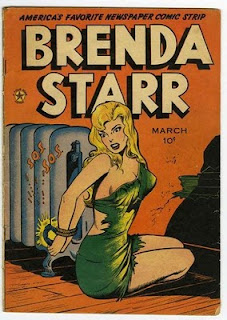Brenda Starr, the groundbreaking female reporter created in 1940 by Dalia (Dale) Messick, is coming to an end. Starr was a standout female character in the Golden Age of comics. Yet, her success was the result of her popularity as a syndicated newspaper cartoon strip, not as comic book property. Messick created the character for the Chicago Tribune Syndicate and despite resistance from the editors, the character resonated with readers. While initially not appearing in the Chicago Tribune, it was relegated to a Sunday supplement, by 1945 Brenda Starr had a daily strip and was one of the most popular characters in the Sunday paper. In that same year, the character made its first cross media appearance in a movie serial, Brenda Starr, Reporter starring Joan Woodbury. By the 1950s the character appeared in over 200 newspapers nationwide. The character's popularity is noteworthy because in an era where women were expected to suppress their career aspiration and return home after World War II, Starr career and actions gave voice to women's desire to pursue fulfillment outside the domestic sphere. A smart, liberated, and functional woman, Starr was always depicted as balancing professional and personal life--rejecting the societal pressure for women stay at home, but at the same time was feminine and had a love life--rejecting the degendering associated use to stigmatize career women.
While superhero comics struggled to provide strong female characters (beyond Wonder Woman), Starr made the jump to comics early. A short lived Brenda Starr, Reporter appeared from Four Star Publications in 1947. A second series was produced in 1948-49 by Superior Publishing. In 1955, Charleston Comics (the original home of characters such as Captain Atom, the Question, and the Blue Beetle) produced perhaps the most successful comic book starring the character. The character would reappear in a 1963 series published by Dell Comics. While comic book success for the character never equaled the newspaper readership, the character continued to be a cross media properties in the 1970s and 1980s. In 1976, a Brenda Starr telefilm starring Jill St. John appeared as an ABC Movie of the Week. In 1989, Brooke Shields starred in a critical and commercial disappointing Brenda Starr movie.
These appearances aside, Brenda Starr has remained a cornerstone of the daily newspaper cartoon page since her debut. Moreover, even after Messick's departure, the creators behind the character have remained women. The current creative duo of writer Mary Schmich and artist June Brigman are ending the series. The reasons for the ending are numerous. While the character's popularity in newspapers was a asset throughout most of its history, the contemporary newspaper market struggles to find readers. Moreover, while Brenda Starr has maintained a updated look and mainstream appeal, the character's appeal is very much middle-American suburban today. Influenced as much by soap opera pacing and characterization as by current events, young women or men are not reading Brenda Starr. For all the character's past glory, young readers know little about the character and have little exposure to the character. So, despite the her historic importance, she doesn't have the popularity or platform she once had to reach readers.
I suspect we will see a nice collection of Brenda Starr strips similar to the IDW's collection of Bloom County. There is no question the character desires that kind of treatment. Still, with the impact of the IPAD still being calibrated, it possible that the traditional newspaper strip might make a comeback. If that happens, I wouldn't be surprise to see Brenda Starr, Reporter make a return appearance.

Comments